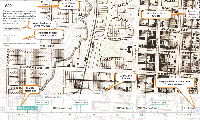
Interesting Maps
American Panorama

American Panorama is an historical atlas of the United States for the twenty-first century. It combines cutting-edge research with innovative interactive mapping techniques, designed to appeal to anyone with an interest in American history or a love of maps.
Atlas for a Changing Planet

Atlas for a Changing Planet
Understanding natural and human systems is an essential first step toward reducing the severity of climate change and adapting to a warmer future. Maps and geographic information systems are the primary tools by which scientists, policymakers, planners, and activists visualize and understand our rapidly changing world. Spatial information informs decisions about how to build a better future.
Avalanche Mapping from AvalancheMapping.Org

Avalanche Mapping
This project collects digital avalanche and snowpit data to promote avalanche information sharing. It is the only project dedicated to building avalanche path atlases and GIS data for avalanche modeling and forecasting. The organization aims to build a database that complies with the guidelines established by the American Avalanche Association, the National Avalanche Center in order to bring readily accessible avalanche data to the public.
Colorado Springs Historic Map Explorer

Colorado Springs Historic Map Explorer is a collection of twenty-four historic maps provided by the City of Colorado Springs Pioneers Museum. These fascinating maps are available in an easy-to-use website for anyone who wants to explore the history and landscapes of the Colorado Springs region.
Google Maps Gallery

Google Maps Gallery
From Life Expectancy in Appalachia to Postal Code Boundaries in Spain, find maps on any topic in Google Maps searchable database of interactive maps. This collection is always growing, since organizations and businesses can upload their favorites.
MapStory
MapStory is an open platform for organizing our knowledge about how the world changes over time and space. Click on a link to the right, and learn how you can start contributing observations of your own.
COGA Pintrest
Social Media
COGA maintains a collection of maps on Pinterest. Connect with us there and have maps for every need at your fingertips!